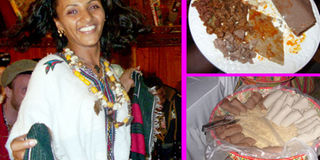Ethiopian ways

Ethiopians are not only naturally beautiful people, but their beauty is enhanced by their ever smiley faces. Top right and below is Injera, the Ethiopian staple food. PHOTOS BY EDGAR R. BATTE
Every culture has its own way of celebrating occasions, Edgar R. Batte attended one of the ceremonies preceeding a marriage in Addis Ababa
Every culture has a unique aspect to it and Ethiopian culture is just as amazingly unique as others. Weddings in Ethiopian tradition ideally take a week, during which the bride and groom make ample preparation during the countdown to their big day. Close to the day, the families, of the bride and groom meet over dinner but not in your upmarket restaurant or hotel – the setting has to be traditional.
I witnessed one in Addis Ababa and the meet was at Fasika National Restaurant. Fasika in means ‘Easter’ in Amharic, a Semitic language, spoken by millions of people across much of the Middle East, North Africa and this Horn of Africa.
The dinner occasion has more revelation to it than the formal get-together of the two families. The dress code for the dinner is formal and women take the day’s prize in beautiful dress embroidery, mostly of white and pink to bring out their stylish, feminine pride. The dresses have beautiful plaits, locally known as sheruba, and these are interweaved to the head or sometimes billowing out at the shoulders.
At sitting time, mixing and mingling is encouraged and both sides, of the bride and groom will freely interact as they share foods from the typical Ethiopian exotically spicy cuisine.
Like the Indians, the Ethiopians love their meals heavily spiced. The food is prepared with lots of spices and for those who might want to add a little more, a lot of spice is availed on the buffet table that’s made up mostly of meat dishes, vegetables and injera their staple food, which is a large sourdough flatbread, made of flour.
To enjoy this meal, you are better off using your fingers for ease when scooping the soup using the injera. The food is shared from a common plate, which as I learnt from Meried Tafsses- a painter who I met at the dinner, the sharing is a demonstration of the bonds of loyalty between family members and friends.
The pots in which the food is served are of heavy and metallic with minimalist designs and the platters are metallic too but at the serving points are clean, hand-made baskets in which some of the foods are put for guests.
But more striking during this dinner is the after-meal session when the cultural troupe raises the tempo. They are hired to provide entertainment and when they begin to perform, everyone is tickled to join given the high-tempo rumba infusions with the traditional Ethiopian music.
The music is the foretaste, if I can call it that, to the traditional Ethiopian dance called Eskesta, which is characterised by electrifying moves that involve the dancers shaking their shoulders in a rhythmical manner.
It starts with the entertainers where a male dancer will do it so well with the female dancer but the couple is rousing enough and before long everyone would like to join in.
At this point, the dinner tables are long removed and there is enough leg room to dance to the tunes. Well, this is not like any other dance but one which calls for creativity to synchronise the shoulder movements to the captivating rhythms from the drums.
It doesn’t matter if you are there on a private dinner arrangement, you will soon be caught in the pulsating frenzy. The dancers are so passionate and do it till they begin to drop lots of sweat off their happy, excited faces. And if you are the shy type, the group of dancers will soon find you and help you to your feet.
And what begins as a mere dance, at some point when the drummers chose to take the tempo higher and higher, becomes a competition on who could last longest shaking the shoulders.
Those who cannot last at shaking their shoulders longer will devise means of blending in other body movements. Eskesta is a dance for all age groups and a unifier for the young and old as the former dare the latter using their agility.
Guests from the two families soon relax in their dance and utilise the moment to interact more on the dance floor and improve on bonds.
This is also an opportunity for the elderly to recapture the delight of their youth when they were more energetic to vigorously move their shoulder bones to the beautiful beats of the drum among other local instruments.
Nonetheless, their attempt cannot be ignored and the younger folks are
willing to let go of the competitions and cheer on their parents and grannies. The songs with which Eskesta is performed are mostly to advise the couple though the singer does this hilariously to keep the cheer in the audience.
Like that, the night grows from young to old and it’s a reason for you to go restaurant hoping the next time you’re in Addis Ababa. The earlier months of the year are good timing. You might get lucky to bump into a night of cultural fun-fair like I did and yes, shake not just a leg but your shoulders to this rich cultural beat.




